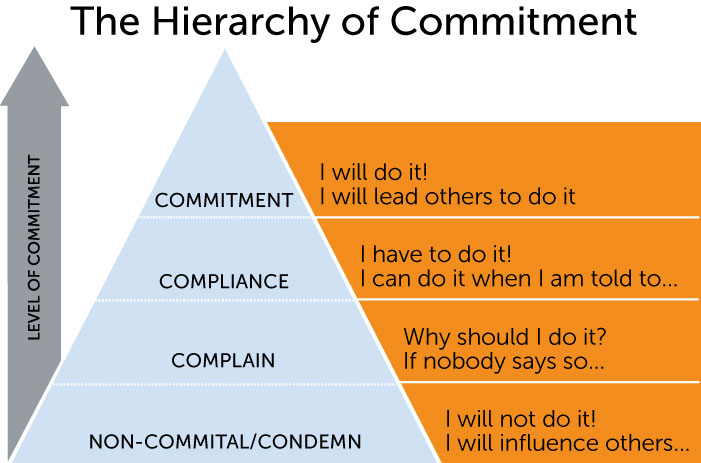As a business aviation leader, how do you help each of your team members choose to be totally committed vs. simply being compliant—or worse yet, non-committal or ambivalent?
If you take a look at the Hierarchy of Commitment chart, a truly committed team member passionately says, “I will do it!”
A compliant team member says, “I can do it if I am told to.” And a non-compliant person says, “I will not do it.”
What is Commitment vs. Compliance?
It’s as about your team being “all in!” vs. “simply going through the motions.” It’s about achieving stellar results vs. just getting buy-in. Think of it as taking on a quest for excellence as opposed to just meeting the minimum performance requirements.
Unfortunately, there’s no magic bullet to motivate everyone to be committed. It will take work and focus on your part.
Let’s examine some of the most critical ingredients to inspire your team members to perform in the “totally committed zone.”
Create a “Culture of Commitment”
As a high-performance leader, you’ll likely recognize that you should motivate your team. And hopefully it’s to perform in their areas of responsibility. After all, you can’t do all the work yourself. So, the inspiration to perform must come from within.
To achieve that, you need to create a “culture of commitment.” This begins with letting your own personal values—your behavior and commitment—become a model for your team members.
Remember, to be a leader, you must have followers and people won’t choose to enthusiastically follow and commit to people who are disingenuous. In short, you must “walk the talk.”
To create a “culture of commitment, “you need to clearly establish the direction and objectives of the organization. And, to be truly effective, the direction and objectives must be inspirational—almost larger than life.
They need to offer real meaning and purpose to the work of your team. As a result, your team members will be able to see that their individual and collective contributions play key roles, and are vital to realizing the organization’s vision and mission. Of course, merely defining direction isn’t nearly enough. You will also have to provide the requisite resources: budget, your time, political capital, coaching, etc.
And, you must also offer your team the third key ingredient: the removal of obstacles and barriers to their performance.
Assess “Fit” vs. “Fitness”
The engine of this “culture of commitment” is, of course, the people on your team. Here, the most important ingredients are fitness.” Whether a person is the right fit for the organization can only be assessed, whereas fitness can be both assessed and developed.
If the fit isn’t there from the onset, don’t kid yourself–it won’t get better with time. The individual simply doesn’t belong on your team. Be decisive, and make the call early and honestly.
Remember that the other members of your team will be assessing you based upon the skill you demonstrate in choosing highly capable and compatible team members. You should expect that each one of your team members will require some level of development to enhance their fitness. However, your failure to confront poor performance is one of the lethal threats to your organization.
Design Individual Performance Plans
Performance targets are always becoming more rigorous. Every team member will be expected to perform at higher and higher levels.Thus, designing and implementing Individual Development Plans (IDPs) is absolutely critical to the sustained success of the entire team.
By investing in this effort, you’ll be rewarded with your team members’ commitment to you as their leader.
Inspire “Followership”
The final element that will influence the powerful commitment of your team is, of course, your prowess as a leader. Next, focus upon these seven components of leadership and you will inspire “followership” from the team!
Know yourself
Have the courage to take that pragmatic and honest look in the mirror. If you don’t truly know yourself, leading others will be virtually impossible.
Know each of your leadership team members
When you align the passions and interests of your people with the goals and objectives of the organization, your toughest task will be to stay out of the way.
Know what’s going on
Stay connected with your team members. When you are interacting with them on an individual or group basis, stay completely in that moment. Develop a laser-like focus that will block out all tangential thoughts or activities.
Develop your team
Commit resources to help them develop their full potential. Commitment generates commitment.
Create a positive environment
Fear and distrust shuts down human creativity and limits our ability to think beyond the “survival mode.”
Engage both your EQ and IQ
To motivate superior, committed performance, you have to win your team members’ hearts and minds. The emotional quotient (EQ) of great leaders eclipses the intelligence quotient (IQ) every time. Your people must select you as their leader, an act that’s driven by their passions and interests and how they perceive them to be in sync with your own.
Trust
It must flow both ways between you and the team. Without this critical element, making a big leap from compliance to being totally committed is simply impossible.
So there you have it.
It certainly sounds simple and straightforward. But in reality it’s neither. Leading an organization to perform consistently in the “totally committed zone” requires, at a minimum, all of the elements highlighted above.
You have to devote your total focus and commitment. The rewards of doing so, however, are a highly aligned organization, functioning at peak performance levels. And, coincidentally, everyone will love what they are doing!
Your Turn
As you can see, “commitment vs. compliance” is a topic that all effective leaders ponder from time to time. So, tell us what you think. What thoughts, ideas or experiences have you had on or about this topic?
